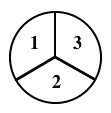

1. If I have the pair of spinners below, what is the probability, when I spin both, that the sum will be 6?


We can take the first spinner and subdivide it into equal fourths, so we can make a table:
| 1 | 1 | 2 | 3 | |
| 1 | 2 | 2 | 3 | 4 |
| 2 | 3 | 3 | 4 | 5 |
| 3 | 4 | 4 | 5 | 6 |
P(3) = 3/12=1/4 (the probability of getting a sum of 3: see yellows)
P(5) = 2/12=1/6 (the probability of getting a sum of 5: see pinks)
Getting a sum of 4 is most likely (because more 4's appear than any other number:
see blues)
2. A. Is it likely or unlikely that this will happen to every Aquarius who is over age 15? (Explain)
Not very likely--it certainly doesn't happen to most people every week
B. Is it likely or unlikely that this will happen to at least one Aquarius who reads Mystico’s column? (Explain)
Yes, if lots of people read the column (say a million or two), it's almost certain that at least one of them will hear from an old friend during the week.
3. B is less specific and therefore more likely (there are lots of personality traits they could have in common: they could both be very neat or very messy, or like crossword puzzles, or be patient, or have a short temper, there's lots of ways they could have similar personalities), A is very specific (not only do their daughters have the same name, but they both have the name Mary--which is a common name, but so is Ann, and Elizabeth...) so it is less likely.
4. It may be likely for a tornado to hit River Falls in any given year, but if you make it River Falls and the surrounding townships (a bigger area) sometime in the next century, or the next 500 years (a longer time span), then you have something fairly likely to happen.